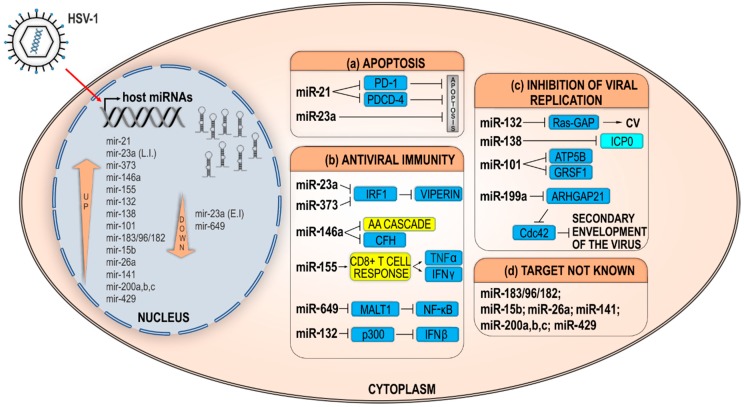Figure 2.
HSV-1 deregulates host miRNAs. A schematic representation of reported deregulated host miRNAs in HSV-1 infection and miRNAs with pro/antiviral functions. HSV-1 infects cells and triggers massive changes in host cell miRNAome. Many miRNAs have been found to be upregulated (arrow up within the nucleus) or downregulated (arrow down in the nucleus). These miRNAs regulate different host (blue boxes) or viral transcripts (light blue box) with functions in (a) regulation of apoptosis, (b) antiviral immunity, (c) inhibition of viral replication, and (d) miRNAs with targets not known depicted in separate boxes. During early infection (EI), miR-23a is downregulated, while later in the infection (LI) miR-23a is upregulated. The exact targets of miR-155 and miR-146a have not been identified; however, they regulate host immune response (yellow boxes) by regulating T-cell differentiation and the arachidonic acid cascade (AA cascade) pathway, respectively. Upregulated miR-132 activates Ras by removing Ras-GAP, leading to corneal neovascularization (CV). Neuron-specific miR-138 regulates virus protein ICP0. Arrows indicate positive regulation. PD-1: Programmed cell death protein 1; PDCD-4: Programmed cell death protein 4; IRF1: Interferon regulatory factor 1; CFH: Complement factor H; TNFα: Tumor necrosis factor alpha; IFNβ/γ: Interferon beta/gamma; MALT1: Mucosa-associated lymphoid tissue lymphoma translocation gene 1; NF-κB: Nuclear factor kappa-light-chain-enhancer of activated B cells; Ras-GAP: Ras–glyceraldehyde-3-phosphate; ICP0: Infected cell polypeptide 0; ATP5B: ATP synthase subunit beta; GRSF1: G-rich sequence factor 1; ARHGAP21: Rho GTPase-Activating Protein 21; Cdc42: Cell division control protein 42 homolog.

